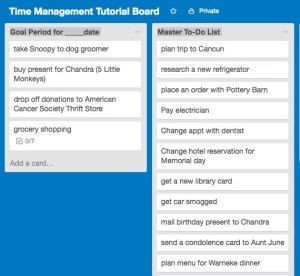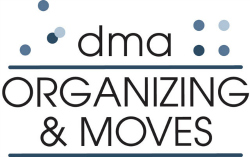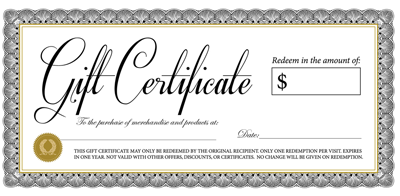Using Goal Periods For Time Management

Breaking a master to-do list into discreet goal periods helps manage the “too much to do overwhelm.” Trello is a free online tool to implement this strategy.
Have you ever had that feeling of overwhelm when you look at your to-do list, see a million items, feel unsure about where to start or even that the work will never end? We have too!
Inspired by her business coach, Sean Hicks, Katherine has been experimenting with using “goal periods” to help bring focus to her workday.
A goal period is a set block of time when you plan to get things done: seeing clients, doing administrative work, paying bills, running errands, doing chores.
Depending on what’s going on, each day can have several goal periods. A typical length of a goal period is 1.5-3 hours. You decide for yourself how long it should be. But it should be consistent for you.
Planning Session
The first step to trying this out is to set aside ½ hour 2 times a week for a planning session. This is the time where you will take stock of your giant to-do list, review your schedule for the next few days and decide when your goal periods will be and which tasks will be in them.
What To Do?
Start by having a look at your master to-do list. Ask these questions to narrow the possibilities of what you’re going to tackle this week:
- What is time sensitive?
- What’s most important?
- How long will each item take?
When To Do It?
Now it’s time to take a look at your calendar and set aside some goal periods for the week. Remember, it’s a good idea to do this planning twice a week so you’ll have a chance to shift items around if needed.
- Block out as many goal periods as your schedule allows (You can have goal periods for exercise and fun stuff too!)
- Decide which tasks are going to happen in which blocks of time.
Get Working!
When a goal period occurs, get to work on the items designated for that time. When the period ends, stop working on those tasks.
This is essential! Once you have committed to doing something within a goal period, if you don’t finish it within that goal period you have to wait until the next planning session to schedule time to work on it.
So how do you get through tasks that will take longer than a goal period allows? Split that task up into parts and schedule those. If your goal period is 2 hours and you have a task that you think will take 6 hours, you need to break that task down into parts and schedule them into 3 different goal periods.
Maintaining these boundaries is a critical part of the goal period strategy. It has helped Katherine feel the joy of accomplishment without feeling the burden of an unending list of to-dos. This technique also helps give you permission to put a period at the end of a work session, with the opportunity to get refreshed and ready to take on the next set of pre-decided tasks.
Have questions on how to implement this for yourself? Ask them here!

